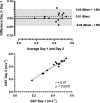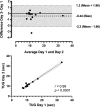Test-retest reliability and agreement of remote home-based functional capacity self-administered assessments in community-dwelling, socially isolated older adults
- PMID: 38778868
- PMCID: PMC11110522
- DOI: 10.1177/20552076241254904
Test-retest reliability and agreement of remote home-based functional capacity self-administered assessments in community-dwelling, socially isolated older adults
Abstract
Objectives: To determine the test-retest reliability and agreement of home-based functional capacity self-administered assessments in socially isolated older adults.
Methods: Fourteen community-dwelling older adults (eight females, 67.9 ± 7.7 years) volunteered for this study. Before testing, participants were screened online for eligibility and received instructional videos explaining test set-up and execution. Participants underwent the 30-second sit-to-standing test, gait speed tests at the usual pace, and timed-up-and-go tests administered 4 weeks apart. For the 30-second sit-to-standing protocol, participants were instructed to repeatedly sit and stand from a chair (with a height of ∼ 43 cm and without armrests) for 30 s, with the number of repetitions recorded. In the gait speed test protocol, participants were instructed to walk at their usual and comfortable pace, with the time taken recorded (seconds). In the timed-up-and-go, participants stood up from a chair, walked as fast as possible for 3 m, circled a marked point, and returned to the chair to sit down, completing the test, with the score recorded (seconds). A trained researcher conducted the scoring virtually via synchronous video.
Results: 30-second sit-to-standing, gait speed test, and timed-up-and-go showed excellent mean coefficient of variation values (2.0-4.9), small standard error of measurement (0.08-1.27), excellent intraclass coefficient (0.97-0.99), very strong correlations (0.97-0.99) and good agreement between the two days of testing.
Conclusion: Self-administered functional capacity tests performed by older adults at home were reliable with good agreement. Healthcare professionals and older adults should take advantage of simple remote self-administered assessments performed at home to evaluate older adults' health status.
Keywords: Functional capacity; aging; home-based-testing; remote administration; self-assessment.
© The Author(s) 2024.
Conflict of interest statement
The authors declared no potential conflicts of interest with respect to the research, authorship, and/or publication of this article.
Figures




Similar articles
-
Validity and Reliability of the Self-Administered Timed Up and Go Test in Assessing Fall Risk in Community-Dwelling Older Adults.Geriatrics (Basel). 2025 Apr 29;10(3):62. doi: 10.3390/geriatrics10030062. Geriatrics (Basel). 2025. PMID: 40407569 Free PMC article.
-
Remote versus face-to-face fall risk assessment in home dwelling older adults: a reliability study.Physiother Theory Pract. 2025 Apr;41(4):827-835. doi: 10.1080/09593985.2024.2367516. Epub 2024 Jun 16. Physiother Theory Pract. 2025. PMID: 38881165
-
A Smartphone-Based Timed Up and Go Test Self-Assessment for Older Adults: Validity and Reliability Study.JMIR Aging. 2025 Mar 21;8:e67322. doi: 10.2196/67322. JMIR Aging. 2025. PMID: 40116726 Free PMC article.
-
Validity, reliability, and measurement error of a sit-to-stand power test in older adults: A pre-registered study.Exp Gerontol. 2021 Mar;145:111202. doi: 10.1016/j.exger.2020.111202. Epub 2020 Dec 19. Exp Gerontol. 2021. PMID: 33347922
-
Measurement properties of the usual and fast gait speed tests in community-dwelling older adults: a COSMIN-based systematic review.Age Ageing. 2024 Mar 1;53(3):afae055. doi: 10.1093/ageing/afae055. Age Ageing. 2024. PMID: 38517125 Free PMC article.
Cited by
-
Effects of home-based exercise with or without cognitive training on cognition and mobility in cardiac patients: A randomized clinical trial.Geroscience. 2025 Feb 3. doi: 10.1007/s11357-025-01530-y. Online ahead of print. Geroscience. 2025. PMID: 39899189
-
The recent history and near future of digital health in the field of behavioral medicine: an update on progress from 2019 to 2024.J Behav Med. 2025 Feb;48(1):120-136. doi: 10.1007/s10865-024-00526-x. Epub 2024 Oct 28. J Behav Med. 2025. PMID: 39467924 Free PMC article. Review.
References
-
- Bell KE, von Allmen MT, Devries MC, et al. Muscle disuse as a pivotal problem in sarcopenia-related muscle loss and dysfunction. J Frailty Aging 2016; 5: 33–41. - PubMed
LinkOut - more resources
Full Text Sources

